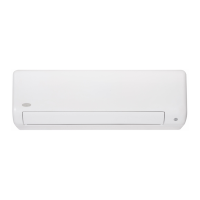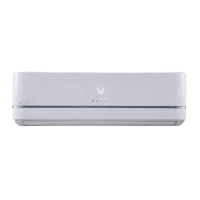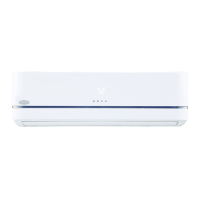Do you have a question about the Carrier 40MAHBQ36XA3 and is the answer not in the manual?
Lists compatible indoor units with specific outdoor units (single zone and multi-zone).
Illustrates required clearances for ceiling and floor installations.
Provides guidelines for wiring, including wire sizing and connection methods.
Important note regarding the insulation of refrigerant lines.
Requires a pump capable of 500 microns and a gauge for measuring vacuum depth.
A multi-step process involving evacuation and nitrogen purging to remove contaminants.
Ensure factory tubing is secure and not rubbing against any metal.
Unit stops if indoor fan speed is too low or too high for a period.
Protects against current, voltage, and temperature issues for the inverter module.
Indoor fan starts 10s after louver activation upon unit startup.
Detects incorrect zero crossing signal intervals, causing the unit to stop.
Protects against sensor malfunctions like open circuits or disconnections.
Outdoor fan and compressor stop; temperature setting disabled.
Describes indoor fan running rules in COOLING mode based on temperature.
Compressor stops if evaporator temperature is less than the set value.
Describes the DEFROSTING mode activation, compressor and motor behavior.
Allows choosing between COOLING, HEATING, or FAN ONLY based on temperature difference.
Specifies fixed indoor fan speed (BREEZE) and low room temperature protection.
Explains that the outdoor fan operates the same as in COOLING mode.
General protections and remote controller are available in this mode.
Compressor runs at F2 frequency, indoor fan in BREEZE mode.
Functions like normal AUTO mode with a fixed temperature.
How to enter and exit the forced defrosting mode.
Emphasizes the need to discharge electricity from capacitors before servicing.
Details malfunction conditions, causes, and troubleshooting for EEPROM errors.
Addresses communication errors between indoor and outdoor units (E1).
Explains diagnosis and solutions for zero crossing detection errors (E2).
Provides diagnosis and solutions for fan speed out of control errors (E3/F5).
Diagnoses issues with indoor/outdoor DC fan motors based on voltage measurements.
Diagnoses outdoor fan motor issues by checking resistance and PCB.
Diagnoses indoor AC fan motor issues based on voltage measurements.
Details diagnosis and solutions for temperature sensor circuit errors (E4/E5/F1/F2/F3).
Explains diagnosis and solutions for refrigerant leakage detection (EC).
Provides diagnosis and solutions for overload current protection (F0).
Explains diagnosis and solutions for IPM or IGBT over-current protection (P0).
Details diagnosis and solutions for over/under voltage protection (P1).
Explains diagnosis and solutions for high compressor temperature protection (P2).
Provides diagnosis and solutions for inverter compressor drive errors (P4).
Instructions on how to measure the resistance of temperature sensors with a tester.
Provides a table of temperature sensor resistance values for T1, T2, T3, T4.
Provides a table of temperature sensor resistance values for T5 (TP).
Includes a table for temperature conversion and IPM continuity check.
Details how to check IPM continuity using a digital tester.
Instructions for removing the front panel and its components like the filter and louver.
Steps for accessing and removing electrical parts, emphasizing anti-static precautions.
Instructions for removing the evaporator, including the front panel, electrical parts, and fan.
Steps to remove the fan motor and fan assembly.
Lists compatible indoor units with specific outdoor units (single zone and multi-zone).
Illustrates required clearances for ceiling and floor installations.
Provides guidelines for wiring, including wire sizing and connection methods.
Important note regarding the insulation of refrigerant lines.
Requires a pump capable of 500 microns and a gauge for measuring vacuum depth.
A multi-step process involving evacuation and nitrogen purging to remove contaminants.
Ensure factory tubing is secure and not rubbing against any metal.
Unit stops if indoor fan speed is too low or too high for a period.
Protects against current, voltage, and temperature issues for the inverter module.
Indoor fan starts 10s after louver activation upon unit startup.
Detects incorrect zero crossing signal intervals, causing the unit to stop.
Protects against sensor malfunctions like open circuits or disconnections.
Outdoor fan and compressor stop; temperature setting disabled.
Describes indoor fan running rules in COOLING mode based on temperature.
Compressor stops if evaporator temperature is less than the set value.
Describes the DEFROSTING mode activation, compressor and motor behavior.
Allows choosing between COOLING, HEATING, or FAN ONLY based on temperature difference.
Specifies fixed indoor fan speed (BREEZE) and low room temperature protection.
Explains that the outdoor fan operates the same as in COOLING mode.
General protections and remote controller are available in this mode.
Compressor runs at F2 frequency, indoor fan in BREEZE mode.
Functions like normal AUTO mode with a fixed temperature.
How to enter and exit the forced defrosting mode.
Emphasizes the need to discharge electricity from capacitors before servicing.
Details malfunction conditions, causes, and troubleshooting for EEPROM errors.
Addresses communication errors between indoor and outdoor units (E1).
Explains diagnosis and solutions for zero crossing detection errors (E2).
Provides diagnosis and solutions for fan speed out of control errors (E3/F5).
Diagnoses issues with indoor/outdoor DC fan motors based on voltage measurements.
Diagnoses outdoor fan motor issues by checking resistance and PCB.
Diagnoses indoor AC fan motor issues based on voltage measurements.
Details diagnosis and solutions for temperature sensor circuit errors (E4/E5/F1/F2/F3).
Explains diagnosis and solutions for refrigerant leakage detection (EC).
Provides diagnosis and solutions for overload current protection (F0).
Explains diagnosis and solutions for IPM or IGBT over-current protection (P0).
Details diagnosis and solutions for over/under voltage protection (P1).
Explains diagnosis and solutions for high compressor temperature protection (P2).
Provides diagnosis and solutions for inverter compressor drive errors (P4).
Instructions on how to measure the resistance of temperature sensors with a tester.
Provides a table of temperature sensor resistance values for T1, T2, T3, T4.
Provides a table of temperature sensor resistance values for T5 (TP).
Includes a table for temperature conversion and IPM continuity check.
Details how to check IPM continuity using a digital tester.
Instructions for removing the front panel and its components like the filter and louver.
Steps for accessing and removing electrical parts, emphasizing anti-static precautions.
Instructions for removing the evaporator, including the front panel, electrical parts, and fan.
Steps to remove the fan motor and fan assembly.
| Brand | Carrier |
|---|---|
| Model | 40MAHBQ36XA3 |
| Category | Air Conditioner |
| Language | English |












